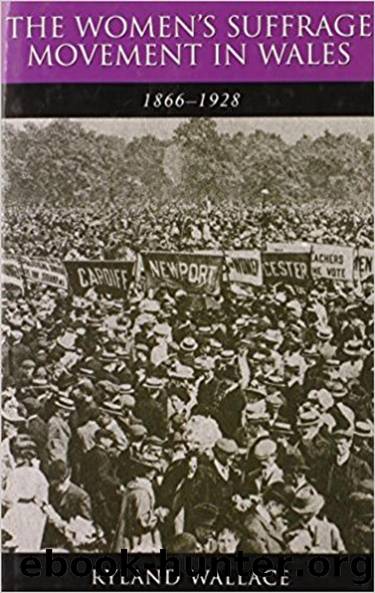The Women's Suffrage Movement in Wales, 1866-1928 by Ryland Wallace

Author:Ryland Wallace [Wallace, Ryland]
Language: eng
Format: epub
Tags: Social Science, Women's Studies, History, Europe, Great Britain, General, Political Science, History & Theory, Civil Rights, Political Process, Campaigns & Elections
ISBN: 9781786833297
Google: Mh9mDwAAQBAJ
Publisher: University of Wales Press
Published: 2018-05-15T04:13:34+00:00
VI
THE IMPACT OF THE FIRST WORLD WAR
âArmageddon in Europe!â excitedly wrote the young Vera Brittain in her diary entry for Monday, 3 August 1914. âOn Saturday evening Germany declared war upon Russia & also started advancing towards the French frontier . . . The great fear now is that our bungling Government will declare Englandâs neutrality.â1 She worried unduly, for Britain entered the conflict the very next day, following the German invasion of Belgium.
The reaction of many suffragists, both militant and constitutional, was instinctive and predictable: war was a calamity, the inevitable result of a man-made world founded on physical force. âWould that we had won our scrap of paper [the ballot] before the Warâ, bemoaned the Forward Cymric Suffrage Union (FCSU) leader, Edith Mansell Moullin.2 WSPU representatives around the country elaborated on this theme. Thus, the south Wales organizer, Annie Williams, told Pontypool branch members that
The war ought never to have been . . . If five years ago the men had enfranchised the women and given them a share in the government of the country it is possible that there would have been no war to-day . . . emancipating woman would have resulted in the attainment of a higher state of civilisation.3
On 10 August, the home secretary, Reginald McKenna, announced the unconditional release of all suffragette prisoners (as well as those gaoled for offences connected with labour unrest). Three days later, in a circular letter to her members, Mrs Pankhurst declared the suspension of all agitation.4 In early September, Christabel Pankhurst returned from her exile in Paris to signal the Womenâs Social and Political Unionâs (WSPU) fervent anti-German campaign and the subordination of womenâs interests to war propaganda. Not all activists were prepared to accept the jingoistic line of Mrs Pankhurst and her eldest daughter, but a number of prominent figures certainly did, most notably âGeneralâ Flora Drummond and Annie Kenney. With remarkable swiftness, suffragette leaders were transformed from public enemies to fierce nationalists. As the Conservative Party leader and three times prime minister, Stanley Baldwin, recalled years later when unveiling a statue to Mrs Pankhurst at Victoria Tower Gardens in the shadow of the Houses of Parliament: âThe World War came. In the twinkling of an eye, at the sound of the trumpet, the revolutionary died, and the patriot was born, and the militant suffragettes laid aside their banners.â5 Patriotism was all, womenâs suffrage was sidelined. The WSPU, in the words of Sylvia Pankhurst, ânow entirely departed from the Suffrage movement. Giving its energies wholly to the prosecution of the War, it rushed to a furious extreme, its Chauvinism unexampled amongst all other womenâs societies.â6 In October 1915, The Suffragette became Britannia and, in November 1917, the WSPU was rechristened the Womenâs Party.
The unwavering path chosen by the WSPU leadership during the war was emphatically not that trodden by all suffrage activists, even within the WSPU itself. Wartime responses were complex but broadly fell into three categories: those who supported the war effort through voluntary welfare
Download
This site does not store any files on its server. We only index and link to content provided by other sites. Please contact the content providers to delete copyright contents if any and email us, we'll remove relevant links or contents immediately.
| General | Channel Islands |
| England | Northern Ireland |
| Scotland | Wales |
Room 212 by Kate Stewart(5014)
The Crown by Robert Lacey(4710)
Endurance: Shackleton's Incredible Voyage by Alfred Lansing(4654)
The Iron Duke by The Iron Duke(4274)
The Rape of Nanking by Iris Chang(4124)
Joan of Arc by Mary Gordon(4000)
Killing England by Bill O'Reilly(3937)
Say Nothing by Patrick Radden Keefe(3891)
I'll Give You the Sun by Jandy Nelson(3343)
Shadow of Night by Deborah Harkness(3277)
Hitler's Monsters by Eric Kurlander(3256)
Mary, Queen of Scots, and the Murder of Lord Darnley by Alison Weir(3135)
Blood and Sand by Alex Von Tunzelmann(3121)
Darkest Hour by Anthony McCarten(3058)
Eleanor & Park by Rainbow Rowell(3039)
Margaret Thatcher: The Autobiography by Thatcher Margaret(3021)
Red Famine: Stalin's War on Ukraine by Anne Applebaum(2857)
Book of Life by Deborah Harkness(2852)
The One Memory of Flora Banks by Emily Barr(2789)
